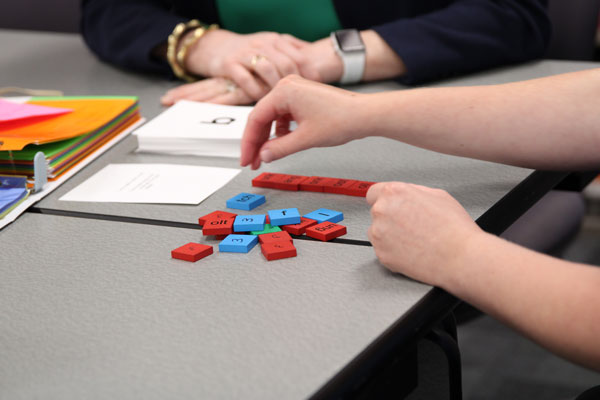Inside Education and Health Sciences

The complexities of teaching children to read
By Emily Clemenson
Elisabeth Friel-Wahle had been teaching third grade for nearly a decade. On paper, her students were meeting all of the benchmarks to promote to fourth grade, but she knew in her heart that some of them weren't reading and spelling proficiently.
"I was just sick over it," Friel-Wahle said. "I kept looking at myself. It has to be something with my teaching. There has to be a way we can reach all children."
So she enrolled in the graduate-level reading preparation endorsement program at the University of Dayton. In the following few years, she could tell that she was connecting to the students even better: teaching them to read, spell and love books. But every year, there were still a few students who were not the proficient readers that they needed to be.
Then Friel-Wahle learned about the dyslexia certificate program at UD, which is accredited by the International Dyslexia Association. Earning the certificate is just two more classes on top of the reading endorsement requirements, so she signed up. She said the courses have changed the way she teaches.
"I've learned to recognize indicators of dyslexia exhibited by any child, and know how to intervene," she said, adding that many students can struggle with just a couple characteristics of dyslexia without ever needing to be diagnosed. "One or two indicators will still inhibit anyone learning to read."
Friel-Wahle still teaches at Ascension School, now as a literacy leader, and she is also an adjunct professor at the University of Dayton teaching the advanced phonics and multisensory instruction course and the practicum that follows.
Students in UD's Department of Teacher Education — especially those in the pre-kindergarten to grade 5 program and the intervention specialist program — are encouraged to add a dyslexia certificate to their undergraduate degree. Established teachers who want to become better teachers of reading and spelling can enroll in the reading endorsement program, a graduate-level dyslexia certificate, or a full Master's degree in literacy.
UD's dyslexia certificate far exceeds Ohio's state requirement of 18 hours of dyslexia training for classroom teachers. And students with a UD dyslexia certificate can take that knowledge and apply for a Structured Literacy/Dyslexia Interventionist certification from the Center for Effective Reading Instruction.
Mary-Kate Sableski is an associate professor and the reading program coordinator for UD's teacher education department, and has been appointed as the Leary Chair for Innovation in Education, Health and Wellness in the School of Education and Health Sciences. In this role, she will develop research and professional development initiatives to support classroom teachers in implementing effective reading and writing instruction.
"We know from research that a classroom teacher who is knowledgeable and empowered to make decisions to support students' complex needs is foundational to their future success," Sableski said. "Our reading programs are designed to give teachers the knowledge and tools they need, grounded in evidence and research, to make good decisions for their students, wherever they teach. The Leary Chair position will help us to extend that reach by creating opportunities for professional development and research programs to support the most important asset in a classroom — the teacher."
The University of Dayton's Department of Teacher Education offers dyslexia certificates, a reading endorsement, and a Master of Science in Education: Literacy program, in addition to its science-based undergraduate reading program in the pre-kindergarten to grade 5 program.
The National Council of Teacher Quality gave UD's program an A+ rating in the 2023 Teacher Prep Review report — and the Fordham Institute also gave us top marks — for our science-backed reading curriculum. Add to that the International Dyslexia Association accreditation and success stories like Friel-Wahle's, it is clear that UD is doing something right.
"There is so much good at UD — including continual opportunities for growth," Friel-Wahle said. "It's worth the struggle for us to continue to learn to be the most effective teachers of reading and spelling that we can be."
